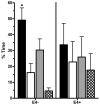Apolipoprotein E4 and sex affect neurobehavioral performance in primary school children
- PMID: 19952867
- PMCID: PMC2853744
- DOI: 10.1203/PDR.0b013e3181cb8e68
Apolipoprotein E4 and sex affect neurobehavioral performance in primary school children
Abstract
Apolipoprotein E4 (apoE4) and female sex are risk factors for developing Alzheimer's disease. It is unclear whether apoE4 contributes to behavioral function at younger ages. Standard neuropsychological assessments [intelligence quotient (IQ), attention, and executive function] and a test developed in this laboratory (Memory Island test of spatial learning and memory) were used to determine whether E4 and sex affect neuropsychological performance in healthy primary school children (age 7-10). A medical history was also obtained from the mother to determine whether negative birth outcomes were associated with apoE4. Mothers of apoE4+ children were more likely to report that their newborn was placed in an intensive care unit. A sex difference in birth weight was noted among apoE4- (males > females), but not apoE4+, offspring. Conversely, among apoE4+, but not apoE4- children, there was a sex difference in the Wechsler Abbreviated Scale of Intelligence (WASI) vocabulary score favoring boys. ApoE4- girls had better visual recall than apoE4+ girls or apoE4- boys on the Family Pictures test. Finally, apoE4+, unlike apoE4-, children did not show spatial memory retention during the Memory Island probe trial. Thus, apoE4 may affect neurobehavioral performance, particularly spatial memory, and antenatal health decades before any clinical expression of neurodegenerative processes.
Figures




 : right, or
: right, or  : opposite quadrant (for additional details, see text).
: opposite quadrant (for additional details, see text).Similar articles
-
In Thai Nationals, the ApoE4 Allele Affects Multiple Domains of Neuropsychological, Biobehavioral, and Social Functioning Thereby Contributing to Alzheimer's Disorder, while the ApoE3 Allele Protects Against Neuropsychiatric Symptoms and Psychosocial Deficits.Mol Neurobiol. 2018 Aug;55(8):6449-6462. doi: 10.1007/s12035-017-0848-0. Epub 2018 Jan 6. Mol Neurobiol. 2018. PMID: 29307083
-
Sex Difference in the Association of APOE4 with Memory Decline in Mild Cognitive Impairment.J Alzheimers Dis. 2019;69(4):1161-1169. doi: 10.3233/JAD-181234. J Alzheimers Dis. 2019. PMID: 31127771
-
Impaired memory-guided attention in asymptomatic APOE4 carriers.Sci Rep. 2019 May 31;9(1):8138. doi: 10.1038/s41598-019-44471-1. Sci Rep. 2019. PMID: 31148578 Free PMC article.
-
Apolipoprotein E4 causes age- and sex-dependent impairments of hilar GABAergic interneurons and learning and memory deficits in mice.PLoS One. 2012;7(12):e53569. doi: 10.1371/journal.pone.0053569. Epub 2012 Dec 31. PLoS One. 2012. PMID: 23300939 Free PMC article.
-
APOE genotype-dependent pharmacogenetic responses to rapamycin for preventing Alzheimer's disease.Neurobiol Dis. 2020 Jun;139:104834. doi: 10.1016/j.nbd.2020.104834. Epub 2020 Mar 12. Neurobiol Dis. 2020. PMID: 32173556 Free PMC article. Review.
Cited by
-
A meta-analysis of sex differences in human navigation skills.Psychon Bull Rev. 2019 Oct;26(5):1503-1528. doi: 10.3758/s13423-019-01633-6. Psychon Bull Rev. 2019. PMID: 31270765 Review.
-
The apolipoprotein E (APOE) gene appears functionally monomorphic in chimpanzees (Pan troglodytes).PLoS One. 2012;7(10):e47760. doi: 10.1371/journal.pone.0047760. Epub 2012 Oct 24. PLoS One. 2012. PMID: 23112842 Free PMC article.
-
Why, After Chemotherapy, is it Necessary to Assess Memory Using Translational Testing?Breast Cancer (Auckl). 2012;6:181-90. doi: 10.4137/BCBCR.S10293. Epub 2012 Nov 19. Breast Cancer (Auckl). 2012. PMID: 23226022 Free PMC article.
-
Progressive loss of synaptic integrity in human apolipoprotein E4 targeted replacement mice and attenuation by apolipoprotein E2.Neuroscience. 2010 Dec 29;171(4):1265-72. doi: 10.1016/j.neuroscience.2010.10.027. Epub 2010 Oct 15. Neuroscience. 2010. PMID: 20951774 Free PMC article.
-
Apolipoprotein E (APOE) genotype has dissociable effects on memory and attentional-executive network function in Alzheimer's disease.Proc Natl Acad Sci U S A. 2010 Jun 1;107(22):10256-61. doi: 10.1073/pnas.1001412107. Epub 2010 May 17. Proc Natl Acad Sci U S A. 2010. PMID: 20479234 Free PMC article.
References
-
- Herz J, Beffert U. Apolipoprotein E receptor: Linking brain development and Alzheimer's disease. Nat Rev Neurosci. 2000;1:51–58. - PubMed
-
- Mahley RW, Weisgraber KH, Innerarity TL, Rall SC., Jr Genetic defects in lipoprotein metabolism. Elevation of artherogenic lipoproteins caused by impaired catabolism. JAMA. 1991;265:78–83. - PubMed
-
- Shao Y, Gearing M, Mirra SS. Astrocyte-apolipoprotein E associations in senile plaques in Alzheimer disease and vascular lesions: a regional immunohistochemical study. J Neuropathol Exp Neurol. 1997;56:376–381. - PubMed

